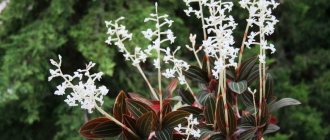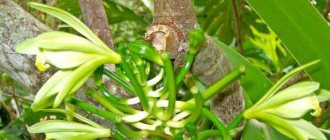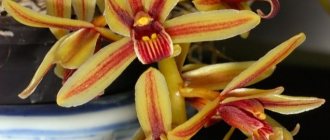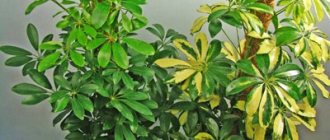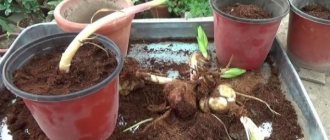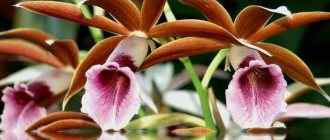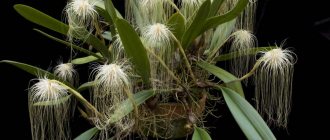Orchids. Magnificent, exquisite, shrouded in mystery, plants have captivated the human imagination for many millennia.
Mention of them can be found already five centuries before the new era by the Chinese philosopher Confucius, who compared the contemplation of orchids with meeting a good friend. The Aztecs worshiped the wondrous plant, considering it a miracle of nature. Europeans began cultivating these tropical flowers in 1698, when the first specimen was brought to Holland.
But
the finicky nature of delicate beauties causes difficulties when growing indoors . It is best to start creating a home collection of orchids with Ludisia, which is characterized by its unpretentiousness to growing conditions.
Precious orchid Ludisia: description of the variety and care at home
Description
Genus Ludisia is an evergreen representative of the Orchid family. Includes one species - Ludisia bicolor, represented by several varieties based on leaf color.
The plant is classified as “precious” because of the beauty of its leaves , because it does not differ in the splendor of flowering.
A small orchid has fleshy, strong stems that spread over considerable distances in diameter and produce multiple vertical shoots.
The stems are soft and fleecy . The plant is attached to the ground or vertical supports using a short rhizome with numerous branches.
IMPORTANT! Ludisia was introduced into indoor culture by the Russian breeder F.A. Bersenev. The uniqueness of the tropical guest lies in its relatively simple cultivation, although it is an exotic flower.
The beauty of Ludisia is provided by its leaves . On the stem they are located in small rosettes of 5 leaves. The leaves are lanceolate or oval-shaped, alternate, on a flat petiole. The length of the leaves is up to 7 cm.
Various colors: dark green, olive, red, brown or black . The upper side of the leaf shimmers in sunlight due to a velvety patterned coating, and the lower surface is smooth, brown or burgundy.
The life cycle of the Ludisia leaf is 7 years . And throughout this period the leaf does not lose its decorativeness and vitality. After the leaves die, a ring scar remains on the stem.
The orchid blooms for about 5 weeks . The plant produces a straight peduncle up to 30 cm high from each rosette of leaves. It blooms with small white flowers with a corolla of yellowish stamens; on each peduncle - up to 30 flowers. When flowering, the orchid emits a delicate aroma and looks like a pearl necklace.
Photo by Ludisia.
Distinctive features
- It has small, inconspicuous flowers and magnificent leaves of various shapes and colors.;
- Able to tolerate fairly dry growing conditions and does not require much sunlight;
- Suitable for breeding by beginners and experienced gardeners;
- Usually blooms in autumn and winter;
- One of the few orchids that lead a terrestrial lifestyle. Grows on moss, rarely attached to walls;
- Does not tolerate bright sunlight and hot air;
- Requires fresh air, but is afraid of drafts;
- Air humidity should be more than 70%.
Distribution in nature
Ludisia's habitat is the moisture-soaked forest floor of the Earth's tropical zone.
The orchid is different in that it likes to settle on the ground under trees or in caves on mossy walls . In the twilight of crevices, under the canopy of crowns, the plant prefers to hide from direct rays.
The geographical area of distribution of the species is quite large. Varieties of orchids are found in many tropical countries : in Malaysia, on the island of New Zealand, in Thailand, New Guinea, and Sumatra.
The Japanese islands, the Indian Peninsula and China have chosen orchids that are tolerant of cooler climates. Deciduous representatives of this species can be found in Brazil and Vietnam. The simplest forms grow in the south of Russia.
Common colors
The colors of Ludisia are determined by the color of the leaves, since all varieties of orchids have white or slightly yellowish flowers. The most popular colors are:
- pink veins on a black and green background;
- bronze surface with copper pattern;
- bright green plate with a lighter pattern of lines;
- dark green leaf with silver coating;
- black with red stripes.
The color of Ludisia is determined by the leaves.
Basic information about the plant
The jewel or variegated orchid, as it is also called, has incredible beauty. A special feature of the flower is the foliage , which has an unusual color. The advantages also include unique buds and their shades. When bloomed, they don’t even look very much like the usual orchid flowers.
The disadvantage of this type of crop is the difficulty of care and the short flowering period. After flowering, the bush becomes similar to other indoor plants. The only thing that makes it stand out is the beautiful color of the leaves. Each plate has a luxurious edge and veins of silver or gold.
The buds of the precious orchid are snow-white. They are collected in small inflorescences. When spread out, they seem to shine against the background of decorative foliage, but at the same time they seem incredibly simple . During the flowering period, the orchid emits a rich, pleasant aroma that fills the entire room.
The precious orchid belongs to the Orchid family. Compared to other species, it is small in size . In nature, the culture prefers to grow in the lands of Madagascar, Australia and Asia.
Reviews
Tatyana Anatolyevna. “We gave Ludisia Alba as a birthday present. It has been growing at home for 8 months. I tried to bloom in November. On the advice of experienced flower growers, I had to remove the peduncle - it was a great pity. But the plant is still young and could die. The orchid is on a western windowsill, there are no problems with lighting. To maintain humidity, I keep a humidifier next to it. The orchid is doing well - the leaves are powerful, bright green with beautiful white veins. A wonderful gift! I am very pleased!"
Alevtina Viktorovna. “I have been growing Ludisia for almost three years. We bought it by chance at a flower market. I really liked the leaves: almost black with a silver velvet pattern. Later I learned that these orchids are called precious because of the beauty of their leaves. At first I was worried that I wouldn’t be able to care for her properly. But my jewel turned out to be picky and makes me happy what a year. It bloomed twice with small flowers with a delicate aroma. I advise everyone to grow such beauty!”
Leoncia. “I want to share my joy: after three years, my Ludisia orchid bloomed! What have I done all these years to persuade her to bloom. As a result, I learned that an orchid blooms in its third year of life. But now an exquisite aroma spreads throughout the apartment. Flowers are like little pearls. Those who consider the flowering of Ludisia to be ordinary are wrong! It's just exquisite beauty! I'm happy!"
Planting Ludizia: preparing the substrate and choosing a flower container
The simplest components of the mixture for precious orchids were proposed back in the last century. They included moss, peat, fern roots, and coarse sand. Quite often, ludisia were planted in living sphagnum moss taken directly from the forest. Modern gardeners use substrates in a much more complex way:
- 4 parts each - high-moor peat, fresh sphagnum moss, rotted leaf soil (preferably collected under beech trees) and green pine needles;
- 1 part each - coarse sand or granulated foam, small pieces of birch charcoal and smaller crushed brick chips.
Experienced orchid growers use such mixtures for planting ludisias and other “gems” in special plexiglass containers, which are a prism 10–20 cm long, 7–10 cm wide and no more than 8 cm high. Drainage slits are made at the lower side ribs of such a glass box to drain excess irrigation water and improve aeration of the root system. The transparent walls of the container allow you to observe the condition of the roots while caring for the Ludisia orchid and other relatives, as well as maintain the viability of sphagnum moss, which is important for the plants being grown and improving the decorative appearance of the entire composition.
At the bottom of the glass container for planting orchids, place a layer of drainage approximately one third of the height, another third with a substrate, and the rest of the space is covered with a thin layer of sphagnum. An orchid or cuttings are placed on top of it for rooting and small pieces of moss are placed vertically around it. Both the substrate and sphagnum do not compact strongly. If the plant is properly cared for, the moss will begin to grow and will most likely need to be trimmed a little.
However, the opinions of many orchid growers boil down to the fact that it is quite acceptable to grow ludisia and other “jewels” in substrates for orchids of a simpler composition, for example, in pure pine bark, with large fractions placed immediately on top of the drainage layer, and small pieces closer to the surface bark. Moss or fern roots, as well as coarse river sand, can be added to this substrate in small quantities. Using the bark, orchids are planted in ceramic or plastic pots, with part of the rhizome buried in it.
External characteristics
The height of an adult plant in its natural habitat is usually 15-20 cm; at home, an orchid does not grow more than 15 cm. But it occupies a significant area due to its numerous branches.
Ludisia is considered a medium-sized but fast-growing crop.
The leaves are the main distinguishing feature of Ludisia, a factor why gardeners love to cultivate this orchid. On each stem of adult specimens there are up to 5 dense, variegated leaves that sparkle in the sun.
In late autumn or winter, erect peduncles 25-30 cm long appear from the center of the upper leaf rosette, on which a raceme with many buds develops. This is how the plant prepares for flowering, which can last for quite a long time, but does not attract the admiration of gardeners.
Ludisia's flowers are small, no more than 2 cm in diameter . The shape is a little reminiscent of Lamiaceae flowers: a long peduncle, the upper petals are round in shape, the lower petals are elongated, slightly beveled to the side. Long yellow stamens crown the white flower, exuding an exquisite aroma. A blooming orchid cluster resembles a bunch of pearls.
Popular types: photos and descriptions
The Ludisia precious orchid has several subspecies, each of which has its own characteristics.
Odina
The foliage of this species has a rich green color; sometimes there are almost black leaves. Decorated with silver veins with side branches.
Alba
The leaves are large, growing up to 5 cm wide, rich green in color. The veins on the leaf are white in the form of a mesh.
Dawsoniana
It is considered the largest variety. The shoots reach a height of 30 centimeters. The leaves are unusual in color - dark red with pink veins.
Velvet (Sapfir Velvet)
The culture is suitable for growing by beginners, as it is unpretentious. The leaves are velvety and come in colors ranging from light green to brown. There are longitudinal veins of white, silver, and sometimes golden color. Has a silvery stem.
Discolor
The stem is creeping, branching. Dark leaves with silver veins grow near the rosette. The peduncle grows up to 20 centimeters in height and is covered with small white flowers.
Main features of flowering
Orchids are representatives of tropical flora and love hot and humid climates. Therefore, flowering in most species occurs in the spring-summer period , the most favorable for seed ripening.
ATTENTION! Ludisia blooms in autumn and winter; this is the best option for it, since it is demanding of excess sunlight and heat.
When optimal conditions are created, Ludisia can bloom for up to 5 weeks . To do this, the plant should not be kept near heating devices or in direct sunlight. An open window requires shading . When the plant is located far from the window, lighting is needed, but no more than 12 hours a day.
Ludisia can bloom for up to 5 weeks.
Repeated flowering is observed mainly in phalaenopsis, but sometimes other orchids repeat flowering - completely unexpectedly. In Ludisia, the peduncle dries out completely, possibly with one or two leaves. But the rows are formed of children who will then give flowers.
Stimulation of flowering of Ludisia must begin in the summer. When the plant is 3 years old and this process will no longer harm it, in order to set buds, the daytime temperature in summer must be maintained in the range from 20 to 29 degrees. Night temperatures are reduced by 3-5 degrees. In autumn, the main thing is to monitor the conditions so that the plant does not go into hibernation. When flowers appear, the thermometer should not rise above 18 degrees to extend the flowering period.
From whom or what can the plant suffer?
Table: Errors in care and their correction
| Error | Cause | Elimination |
| The plant is very elongated. | The orchid does not have enough light. | If the plant is grown in the back of the room, do not forget about additional lighting. |
| The tips of the leaves dry out and become dull. | Low indoor humidity. | Spray the plant in a timely manner. |
| Leaves lose turgor. | Drying of the root ball. | Do not allow the substrate to dry out completely. |
| Ludisia begins to fade, the leaves turn pale. | The plant suffers from too much light. | When growing an orchid on a window, be sure to shade it from bright light. |
| The leaves turn red. | Watering too often. | Water Ludisia only after the top layer of the substrate has dried. |
Sometimes the plant drops its lower leaves. If the orchid looks quite healthy, then this is a natural process. Don't worry and watch the orchid. Usually, after flowering, Ludisia may begin to lose leaves, but at the same time lateral shoots should appear on the shoot.
Try orchid varieties from a trusted supplier:
